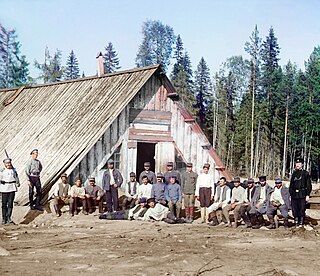
The Battle of Ocaña was fought on 19 November 1809 between French forces under Marshal Nicolas Jean de Dieu Soult, Duke of Dalmatia and King Joseph Bonaparte and the Spanish army under Juan Carlos de Aréizaga, which suffered its greatest single defeat in the Peninsular War. General Juan Carlos de Aréizaga's Spanish army of 51,000 lost nearly 19,000 killed, wounded, prisoners and deserters, mostly due to the French use of their cavalry. Tactically, the battle was a Cannae-like encirclement of the Spanish army. The strategic consequences were also devastating, as it destroyed the only force capable of defending southern Spain; the area was overrun over the winter in the Andalusia campaign.
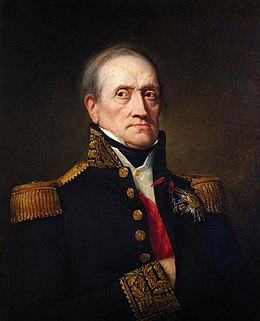
Marshal General Jean-de-Dieu Soult, 1st Duke of Dalmatia, was a French general and statesman, named Marshal of the Empire in 1804 and often called Marshal Soult. Soult was one of only six officers in French history to receive the distinction of Marshal General of France. The Duke also served three times as President of the Council of Ministers, or Prime Minister of France.

The Battle of Albuera was a battle during the Peninsular War. A mixed British, Spanish and Portuguese corps engaged elements of the French Armée du Midi at the small Spanish village of Albuera, about 20 kilometres (12 mi) south of the frontier fortress-town of Badajoz, Spain.
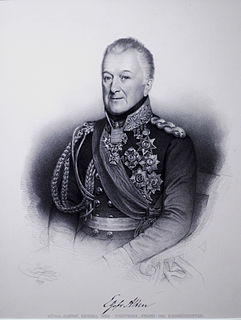
Field Marshal Sir Charles (Carl) August von Alten was a Hanoverian and British soldier who led the famous Light Division during the last two years of the Peninsular War. At the Battle of Waterloo, he commanded a division in the front line, where he was wounded. He later rose to the rank of Field Marshal in the Hanoverian army.

Maximilien Sébastien Foy was a French military leader, statesman and writer.

The Battle of Orthez saw the Anglo-Portuguese Army under Field Marshal Arthur Wellesley, Marquess of Wellington attack an Imperial French army led by Marshal Nicolas Soult in southern France. The outnumbered French repelled several Allied assaults on their right flank, but their center and left flank were overcome and Soult was compelled to retreat. At first the withdrawal was conducted in good order, but it eventually ended in a scramble for safety and many French soldiers became prisoners. The engagement occurred near the end of the Peninsular War.
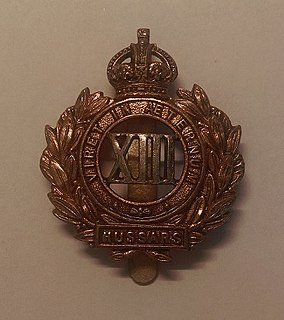
The 13th Hussars was a cavalry regiment of the British Army established in 1715. It saw service for three centuries including the Napoleonic Wars, the Crimean War and the First World War but then amalgamated with the 18th Royal Hussars, to form the 13th/18th Royal Hussars in 1922.
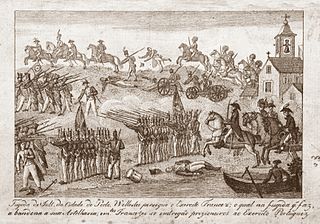
The Second Battle of Porto, also known as the Battle of the Douro or the Crossing of the Douro, was a battle in which General Arthur Wellesley's Anglo-Portuguese Army defeated Marshal Nicolas Soult's French troops on 12 May 1809 and took back the city of Porto. After taking command of the British troops in Portugal on 22 April, Wellesley immediately advanced on Porto and made a surprise crossing of the Douro River, approaching Porto where its defences were weak. Soult's late attempts to muster a defence were in vain. The French quickly abandoned the city in a disorderly retreat.
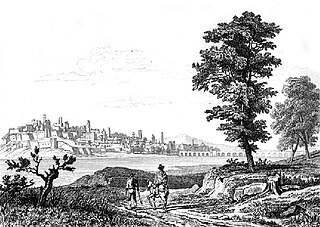
The Battle of the Gebora was a battle of the Peninsular War between Spanish and French armies. It took place on 19 February 1811, northwest of Badajoz, Spain, where an outnumbered French force routed and nearly destroyed the Spanish Army of Extremadura.

At the Siege of Burgos, from 19 September to 21 October 1812, the Anglo-Portuguese Army led by General Arthur Wellesley, Marquess of Wellington tried to capture the castle of Burgos from its French garrison under the command of General of Brigade Jean-Louis Dubreton. The French repulsed every attempt to seize the fortress, resulting in one of Wellington's rare withdrawals, as he went on to defeat the army sent to flank him at the Lines of Torres Vedras, pursued them and then returned to complete the siege of Burgos and capture the city. The siege took place during the Peninsular War, part of the Napoleonic Wars. Burgos is located about 210 kilometres (130 mi) north of Madrid.
This is the order of battle for the Battle of Albuera. The Battle of Albuera was an engagement of the Peninsular War, fought between a mixed British, Spanish, and Portuguese corps and elements of the French Armée du Midi. It took place at the small Spanish village of Albuera, about 12 miles (20 km) south of the frontier fortress-town of Badajoz, Spain. Marshal Sir William Beresford had been given the task of reconstructing the Portuguese army since February 1809. He temporarily took command of General Rowland Hill's corps while Hill was recovering from illness, and was granted overall command of the Allied army at Albuera by the Spanish generals, Joaquín Blake y Joyes and Francisco Castaños.

In the Battle of Maguilla a British cavalry brigade led by Major General John Slade attacked a similar-sized French cavalry brigade commanded by General of Brigade Charles Lallemand. The British dragoons scored an initial success, routing the French dragoons and capturing a number of them. The British troopers recklessly galloped after their foes, losing all order. At length, the French reserve squadron charged into the British, followed by the French main body which rallied. With the tables turned, the French dragoons chased the British until the horses of both sides were too exhausted for the battle to continue. The action took place during the Peninsular War, near Maguilla, Spain, a distance of 17 kilometres (11 mi) northeast of Llerena.
The Battle of Garris or Battle of Saint-Palais saw an Allied force under the direct command of General Arthur Wellesley, Marquess Wellington attack General of Division Jean Harispe's French division. The French defenders were driven back into the town of Saint-Palais in confusion. Because of this minor victory, the Allies were able to secure a crossing over the Bidouze River during this clash from the final stages of the Peninsular War.
This is the order of battle for the Battle of Vitoria.
This is the order of battle for the Battle of Bussaco, 27 September 1810.
This is the order of battle for the Battle of Fuentes de Oñoro, which took place on 3–6 May 1811.
This is the order of battle for the Battle of Corunna, 16 January 1809.

The campaign in south-west France in late 1813 and early 1814 was the final campaign of the Peninsular War. An allied army of British, Portuguese and Spanish soldiers under the command of Arthur Wellesley, 1st Duke of Wellington fought a string of battles against French forces under the command of Marshal Jean de Dieu Soult, from the Iberian Peninsula across the Pyrenees and into south-west France ending with the capture of Toulouse and the besieging of Bayonne.

The Battle of Orthez saw the Anglo-Portuguese Army commanded by Field Marshal Arthur Wellesley, Marquess of Wellington attack a Imperial French army under Marshal Nicolas Jean de Dieu Soult. Soult's army was posted on a ridge to the north of the town of Orthez in southern France and in the town itself. For over two hours the outnumbered French repulsed repeated Allied assaults on their right flank, forcing Wellington to order a general assault. After a struggle, the Allies overcame the French defenses and Soult was compelled to order a retreat. At first, the French divisions withdrew in good order, but as they approached the bridge over the Luy de Béarn at Sault-de-Navailles, many soldiers began to panic. The next day Soult decided that his army was too demoralized to resist more attacks and continued his retreat. Allied casualties were about 2,200 while the French lost about 4,000 killed, wounded and captured. The battle was fought near the end of the Peninsular War.



